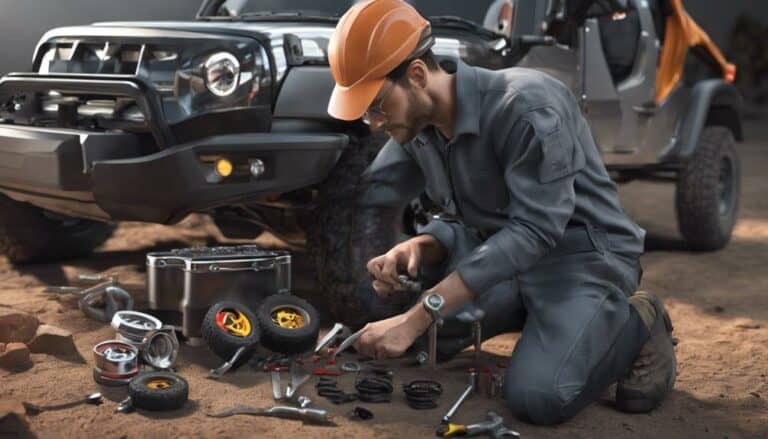When gearing up for your next off-road adventure, remember that checking your tire pressure can make all the difference in maintaining control on rugged terrain. But that's just the beginning.
Have you ever wondered what other essential tasks you should prioritize to guarantee your off-road riding safety? Let's explore the key maintenance and inspection steps that will keep you cruising smoothly through challenging trails.
Key Takeaways
- Regularly inspect tires for proper pressure, tread depth, and rotation to enhance off-road traction and performance.
- Check engine fluids and components for efficient operation and smooth rides on rugged terrains.
- Ensure suspension and steering systems are well-maintained to handle off-road challenges effectively.
- Regularly inspect and maintain the brake system, electrical components, and lights for safe off-road riding experiences.
Tire Maintenance and Inspection
Inspecting and maintaining your tires regularly is essential for ensuring safe off-road riding experiences. Start by checking your tire pressure before each ride using a reliable gauge. Proper tire pressure is vital for the best traction, handling, and stability on challenging terrains.
Additionally, inspect the tire tread depth to make sure it meets the recommended levels. Adequate tread depth provides the necessary grip to prevent slipping and maintain control over uneven surfaces.
To prolong the lifespan of your tires and promote even wear, consider rotating them periodically. This practice helps distribute the wear more evenly, ensuring consistent performance throughout the tire's life cycle.
Furthermore, investing in specialized off-road tires with deeper treads can greatly enhance your riding experience in demanding environments. These tires are designed to offer improved traction, durability, and performance, making them ideal for off-road adventures where standard tires may fall short.
Engine and Fluid Checks
To guarantee excellent performance and longevity of your off-road vehicle, maintaining proper engine function and fluid levels is vital. Here are the key engine and fluid checks you should regularly conduct:
- Engine Oil: Regularly check oil levels to ensure proper lubrication, preventing engine damage.
- Brake Fluid: Inspect brake fluid levels for efficient braking performance.
- Transmission Fluid: Check transmission fluid to maintain smooth gear shifts and best performance.
- Fuel Levels: Monitor fuel levels to avoid running out of gas in remote off-road locations.
- Air Filter: Inspect air filters for cleanliness to promote efficient combustion and engine performance.
Suspension and Steering Components
Regularly inspecting the suspension and steering components of your off-road vehicle is important for maintaining ideal performance and safety. Start by checking the suspension components, including shocks, springs, and bushings, for any signs of wear or damage.
Make sure that the steering components such as tie rods, ball joints, and steering linkage are properly aligned and securely tightened to prevent any issues while riding. Proper lubrication of both the suspension and steering parts is essential to guarantee smooth operation and reduce friction, so make sure to keep them well-maintained.
Additionally, monitor the suspension system for any indications of leaks, as these could signal underlying problems that need attention. Be attentive to any unusual noises or vibrations coming from the suspension and steering systems and address them promptly to prevent further damage.
Brake System Inspection
Guarantee the integrity of your off-road vehicle's brake system by conducting thorough inspections and maintenance checks to uphold peak performance and safety standards.
When inspecting your brake system, pay close attention to the following key areas:
- Brake Pads: Regularly inspect brake pads for wear and tear to secure peak braking performance.
- Brake Fluid: Check brake fluid levels and color regularly to maintain proper hydraulic function.
- Brake Lines: Examine brake lines for leaks, cracks, or damage that could compromise braking efficiency.
- Brake System Testing: Test the brake system by applying gradual pressure to the brakes to verify responsiveness.
- Address Issues Promptly: Address any brake system issues promptly to avoid safety hazards and maintain control during off-road rides.
Electrical System and Lights Check
Guarantee the dependability of your off-road vehicle's electrical system and lights by conducting a thorough inspection to identify any potential issues. Start by checking the battery for proper voltage levels to guarantee reliable starting and operation of the electrical components. Inspect wiring connections meticulously for any signs of wear or corrosion that could lead to electrical malfunctions. Test all lights, including headlights, brake lights, and turn signals, to confirm they are functioning correctly. Promptly replace any burnt-out bulbs to maintain visibility and comply with safety regulations. It is essential to keep spare fuses and bulbs in your emergency kit for quick replacements during your off-road adventures.
| Electrical System and Lights Check |
|---|
| Check Battery Voltage Levels |
| Inspect Wiring Connections |
| Test All Lights |
| Replace Burnt-Out Bulbs |
| Keep Spare Fuses |
Conclusion
To sum up, ensuring the safety and performance of your off-road vehicle requires regular maintenance and inspection tasks.
By taking the time to check and maintain key components such as tires, engine fluids, brakes, suspension, and electrical systems, you can enjoy smooth and safe rides on challenging trails.
Remember, a well-maintained ATV is a reliable companion for your off-road adventures.

